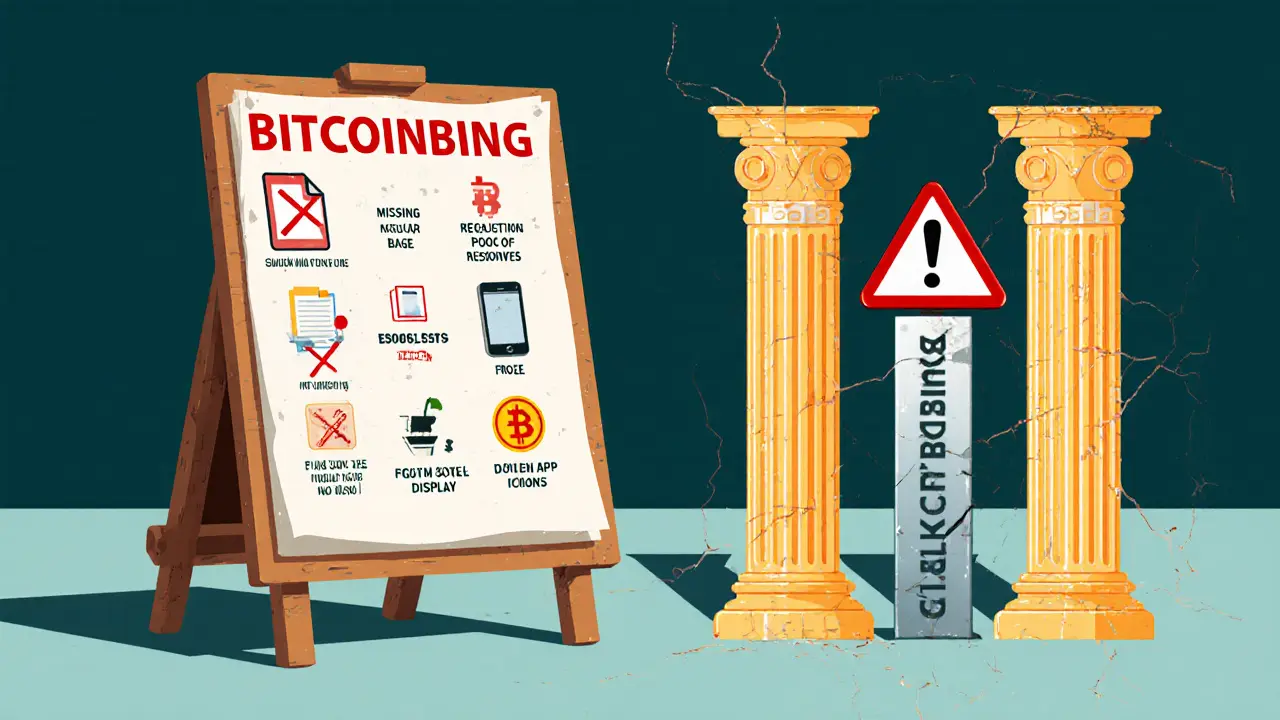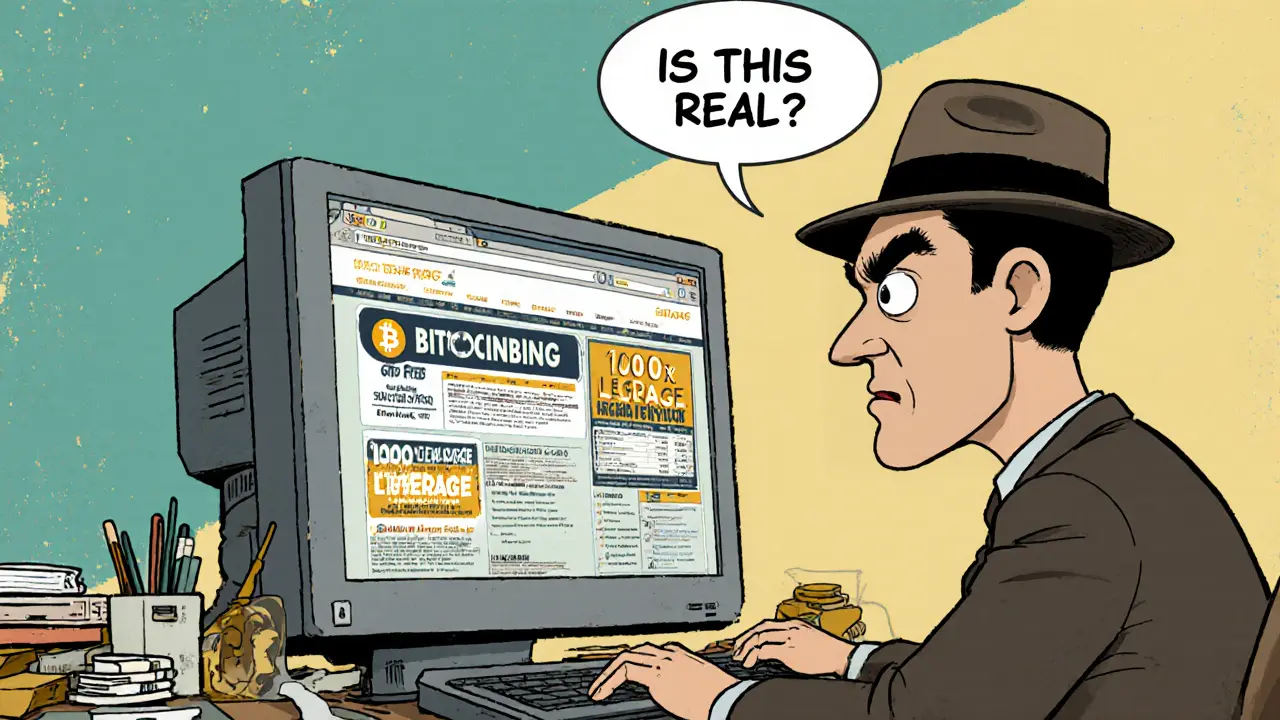Crypto Exchange Legitimacy Checker
This tool helps you quickly evaluate if a cryptocurrency exchange meets basic legitimacy standards. Based on industry best practices, check the boxes below to determine if the exchange is likely safe or potentially a scam.
Legitimacy Checklist
When you hear the name BITCOINBING is a supposed cryptocurrency exchange that claims zero fees and massive leverage, the first question should be “Is this real?” In 2025 the crypto world is crowded with big players, strict regulators, and a steady stream of scams. This review cuts through the hype, looks at the data, and tells you exactly what to watch for before you click ‘Buy.’
Why a Review Matters Now
Bitcoin’s price has been hovering near $100,000 for months, and retail investors are desperate for cheap ways to get in. That desperation fuels platforms that promise “zero fees,” “1000x leverage,” and “instant withdrawals.” Unfortunately, many of those promises turn out to be empty. A solid review helps you separate the few legitimate exchanges from the rest of the noise.
Legitimacy Checklist - What a Real Exchange Looks Like
Before we dive into BITCOINBING’s specifics, let’s lay out the baseline a trustworthy exchange must meet in 2025:
- Registered with a recognized regulator (SEC, FINRA, MiFID II, etc.)
- Public proof of reserves or third‑party audit reports
- Transparent fee schedule published on the website
- KYC/AML procedures that verify users’ identities
- Cold‑storage solutions for the majority of user funds
- Active mobile apps with real download numbers
- API documentation that returns live data, not 404 errors
If an exchange can’t tick at least five of these boxes, treat it with extreme caution.
BITCOINBING’s Red Flags
Here are the concrete issues that surface when we apply the checklist to BITCOINBING:
- No regulator registration. A search of the SEC’s enforcement database shows no filing for BITCOINBING, whereas Coinbase is a U.S.-based crypto exchange founded in 2012 and regulated by the SEC and Binance is a global exchange that holds dozens of money‑transmitter licenses worldwide both list their licensing clearly.
- Missing proof of reserves. Legit platforms like Kraken is a exchange that publishes quarterly audits and proof‑of‑reserve reports upload PDFs to their security page. BITCOINBING never shares a single audit link.
- Zero‑fee claim without a revenue model. Industry analysts, including Charlie Morris of Nugget’s News, warn that “zero‑fee platforms without transparent income are usually honeypots.” BITCOINBING’s website lists no trading fees but also no spread or service charges.
- Fake balance displays. Users on Reddit is a forum where thousands of crypto investors discuss scams and trends have posted screenshots of BITCOINBING showing a balance that never updates after deposits.
- Scam reports on review sites. Trustpilot is a consumer review platform that uses verified ratings lists an average score of 1.2/5 for BITCOINBING, with 87 confirmed scam reports as of October 2025.
- No mobile app presence. Both the Apple App Store and Google Play show zero downloads for any “BITCOINBING” app, while legitimate rivals like Gemini is a exchange that reports 10 million+ monthly active users across its iOS and Android apps proudly display download badges.
- Dead API endpoints. CryptoSlate’s October 2025 verification script tried the three public API URLs BITCOINBING publishes; each returned a 404 error.
Combine these issues, and the picture is clear: BITCOINBING lacks the core infrastructure any reputable exchange needs.

Side‑by‑Side Comparison with Legitimate Exchanges
| Feature | BITCOINBING | Coinbase | Binance | Kraken |
|---|---|---|---|---|
| Regulatory registration | No public registration | SEC & FINRA (US) | Multiple state licenses (US), global compliance | MI5 & FCA (UK), SEC (US) |
| Proof of reserves | None provided | Monthly audit reports | Quarterly transparency reports | Quarterly audits |
| Fee structure | Claims 0 % fee - no breakdown | 0‑4 % depending on volume | 0 % maker, 0.1 % taker (spot) | 0‑0.26 % taker |
| KYC/AML | No verification required (red flag) | Full KYC required | KYC for fiat, optional crypto‑to‑crypto | Full KYC required |
| Mobile app downloads | 0 (none listed) | 10 M+ (iOS & Android) | 5 M+ (iOS & Android) | 3 M+ (iOS & Android) |
| API status | All endpoints 404 | Live REST & WebSocket APIs | Live REST & WebSocket APIs | Live REST & WebSocket APIs |
The table makes it obvious: every major metric where legitimate exchanges shine is either missing or deliberately hidden on BITCOINBING.
How to Protect Yourself If You’ve Already Deposited
If you’ve already sent crypto to a BITCOINBING address, act fast:
- Record the transaction hash. Use a block explorer (e.g., Etherscan for ETH, Blockstream for BTC) to prove the funds left your wallet.
- Report to your local regulator. In Canada, the Ontario Securities Commission takes crypto‑exchange complaints seriously.
- File a report with Chainalysis or CipherTrace. They can flag the address, potentially preventing the scammers from moving the coins.
- Alert your wallet provider. Some services can add a “watch‑only” tag to problematic addresses.
- Consider a legal route. A small claim in your jurisdiction may recover the funds if the operator is identified.
Remember, crypto transactions are irreversible. The sooner you gather evidence, the better your chances of getting help.

What to Look for in a New Exchange - Quick Reference
Use this cheat‑sheet when evaluating any new platform:
- Check regulator listings (SEC, FCA, local financial authority).
- Search for a recent third‑party audit or proof‑of‑reserves report.
- Read independent user reviews on Trustpilot, Reddit, and crypto‑specific forums.
- Verify the mobile app’s download count and rating.
- Test the public API - a live response means the backend exists.
- Look for transparent fee tables; avoid “zero‑fee” claims without a source.
- Confirm KYC/AML steps; no verification is a major warning sign.
Following these steps will keep you far away from scams like BITCOINBING.
Final Verdict on BITCOINBING
Based on regulator checks, user feedback, technical tests, and industry analysis, BITCOINBING fails every credibility test. The platform appears to be a high‑risk, unregistered service that lures users with unrealistic promises. The safest move is to avoid it entirely and stick with exchanges that openly share their compliance documents, audit reports, and fee structures.
Is BITCOINBING a licensed crypto exchange?
No. As of October 2025 there is no record of BITCOINBING being registered with the SEC, FINRA, or any other major regulator. Legit exchanges always publish their license numbers.
Why do users report scams on Trustpilot and Reddit?
Multiple users have posted that deposits never appeared in their BITCOINBING account and withdrawal requests were ignored. Trustpilot shows an average rating of 1.2/5, while Reddit’s r/CryptoScams has over a hundred threads warning others.
Can I trade on BITCOINBING with zero fees safely?
Zero‑fee claims are rarely sustainable. Without a transparent revenue model, an exchange must be making money elsewhere-usually by stealing user funds. It’s best to avoid any platform that offers “free forever” trading.
What should I do if I’ve already sent crypto to BITCOINBING?
Record the transaction hash, report the incident to your local financial regulator, and submit the address to blockchain‑forensics firms like Chainalysis. While recovery is rare, you’ll at least help authorities track the scammers.
Which exchanges are considered safe in 2025?
Coinbase, Binance, Kraken, and Gemini all meet regulator, audit, and security standards. They publish fee tables, have active mobile apps, and provide public API endpoints that work.


PRIYA KUMARI
October 22, 2025 AT 03:22BITCOINBING is a scam painted with fancy buzzwords.
Jessica Pence
October 29, 2025 AT 02:02Hey folks, just a quick heads‑up on how to vet a new exchange. First, check if they’re listed on any regulator’s website – the SEC or FCA will have a public record. Second, look for a proof‑of‑reserves report; most legit platforms post a PDF or a blockchain proof. Third, test the API yourself – a 404 means they’re hiding something. Finally, read user reviews on Trustpilot and Reddit; if the majority are negative, steer clear. Stay safe out there!
Lindsey Bird
November 5, 2025 AT 00:42OMG, this reads like a horror story for crypto newbies! My heart stopped reading the “zero‑fee” claim.
Stephen Rees
November 11, 2025 AT 23:22While Priya hurls accusations, one must consider the broader ecosystem of shadow exchanges that thrive on regulatory blind spots. The very absence of a license can be a deliberate shield, obscuring ties to offshore entities that manipulate markets. If you trace the IP of the domain, you’ll find it hops through multiple anonymizing services, a classic red flag. Moreover, the pattern of dead APIs mirrors tactics used by past rug‑pull platforms. In short, the lack of transparency isn’t just a mistake; it’s a symptom of a deeper, coordinated effort to evade oversight.
Katheline Coleman
November 18, 2025 AT 22:02Thank you for the thorough breakdown. In addition to the points raised, I would recommend checking the exchange’s corporate registration in the jurisdiction where it claims to operate. A simple search in the local business registry can reveal whether the entity truly exists or is a shell. Also, verify the SSL certificate details; some fraudulent sites use mismatched or expired certificates. Finally, consider reaching out to the exchange’s support with a specific query – authentic platforms typically respond within 24‑48 hours. These steps together form a robust due‑diligence checklist.